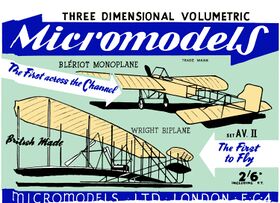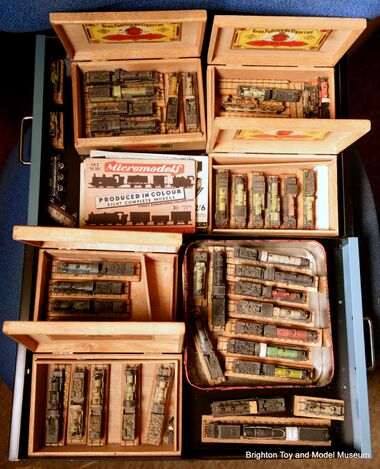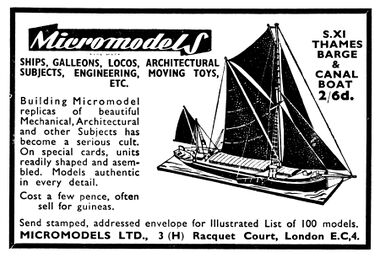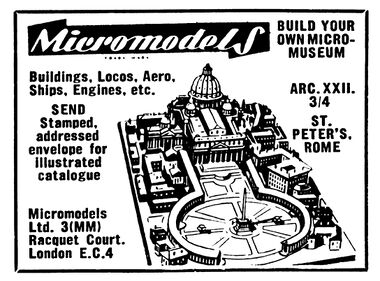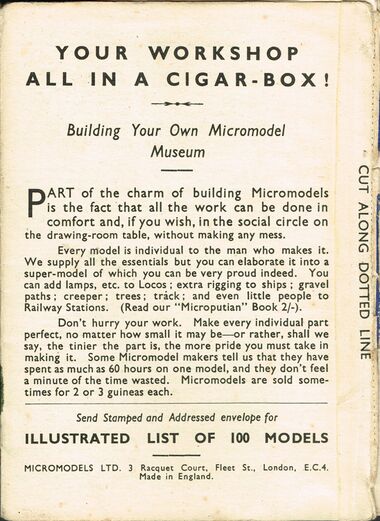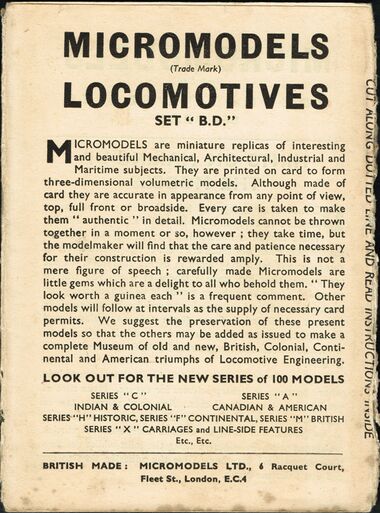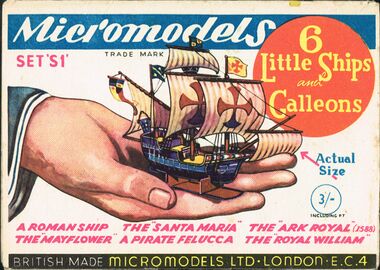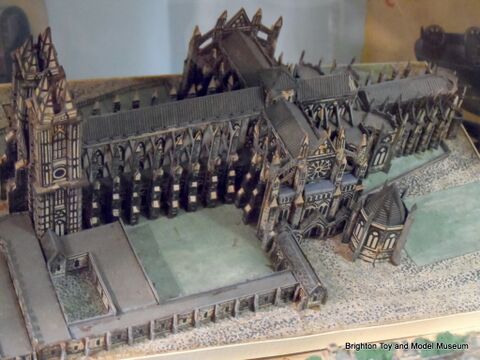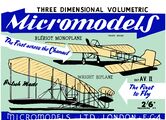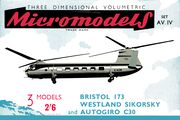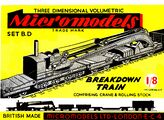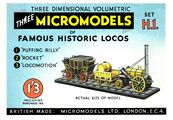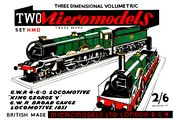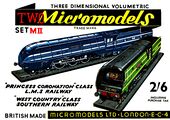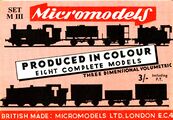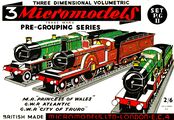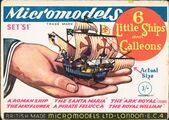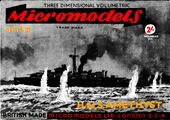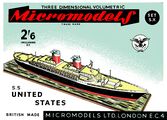Category:Micromodels
| Toy Brands and Manufacturers |
|---|
Micromodels |
| 1940s - |
Part of the Museum's archived collection of Micromodels card steam locomotive models, stored in their traditional cigar-boxes [image info]
1953: Advert in Hobbies Weekly [image info]
1954: St Peter's Basilica, Micromodels ARC XXII [image info]
"Your Workshop in a Cigar-Box [image info]
A different pack rear promotional panel [image info]
Micromodels S1: "Six Little Ships and Galleons" [image info]
Micromodels are intricately detailed "3D Volumetric" card models designed by Geoffrey Heighway (1884-1959), initially when he was working for Modelcraft Ltd. in London.
Micromodels did especially well during WW2 and during the austerity period afterwards, when people were looking for inexpensive hobbies and some other other modelmaking materials (like metal) were restricted. The "small postcard"-sized packs could be kept in a cigarbox along with all necessary tools, and the box could also hold the growing model, and ensure that it wasn't accidentally swept aside or sat on. During the war, it was even suggested that people could bring their Micromodels cigarboxes down with them into the air raid shelters during a raid, and use them to while away the time waiting for the "all clear".
At various times, some of the designs were issued as packs of postcards, printed on the back of Weetabix packets, and/or reissued as compilations in book form.
The "Cigar-Box" Workshop:
YOUR WORKSHOP ALL IN A CIGAR-BOX!
Building Your Own Micromodel Museum
Part of the charm of building Micromodels is the fact that all the work can be done in comfort, and if you wish, in the social circle of the drawing-room table, without making any mess.
Every model is individual to the man who makes it. We supply the essentials but you can elaborate it into a super-model of which you can be very proud indeed. You can add lamps, etc. to Locos; extra rigging to ships; gravel paths; creeper; trees; track; and even little people to Railway Stations.
Don't hurry your work. Make every individual part perfect, no matter how small it may be – or rather, shall we say, the tinier the part is, the more pride you must take in making it. Some Micromodel makers tell us that they have spent as much as 60 hours on one model, and they don't feel a minute of the time wasted. Micromodels are sold sometimes for 2 or 3 guineas each.
— , Micromodels, , Micromodels pack, rear,
Sample cover art
"100 models"
talk of card shortages suggests that this was written during or just after WW2:
Micromodels Locomotives Set "B.D."
MICROMODELS are miniature replicas of interesting and beautiful Mechanical, Architectural, Industrial and Maritime subjects. They are printe don card to form three-dimensional volumetric objects. Although mad eof card they are accurate in appearance from any point of view, top, full front or broadside. Every care is taken to make them "authentic" in detail. Micromodels cannot be thrown together in a moment or so, however; they take time, but the modelmaker will find that the care and patience necessarly for their construction is rewarded amply. This is not a mere figure of speech; carefully made Micromodels are little gems which are a delight to all who behold them. "They look worth a guinea each" is a frequent comment. Other models will follow at intervals as the supply of necessary card permits. We suggest the preservation of these present models so that other may be added as issued to make a complete Museum of old and new, British, Colonial, Continental and American triumphs of locomotive engineering.
Look out for the new series of 100 models
- Series A: Canadian and American
- Series C: Indian and Colonial
- Series F: Continental
- Series H: Historic
- Series M: British
- Series X: Carriages and Line-side Features Etc., Etc.
Guidance
CONSTRUCTIONAL NOTES
Some of the following notes and suggestions are general and may not apply specifically to the particular model you are now about to make. They are given for the assistance of those who for the first time are approaching this absorbing life-long hobby of Micromodel making. Specific instructions where necessary are given on individual cards.
- Micromodels are not toys and should not be associated with Children's cut-out books. These latter often can be assembled in a very few minutes by inserting tongues in slots or pasting down tags ; all very simple, but unrewarding to the serious model-maker, no matter how young.
- Some Micromodels take 60 hours. Don't hurry : enjoy every minute, then you will build little gems as they have so often been called, really worth contemplating and showing with pride.
- Edges to be joined, after cutting with a keen blade, are brought together and fixed using the minimum amount of adhesive. It is a good idea to spread a small quantity on each edge or surface, and then if necessary to draw a sharpened match-stick moistened with the adhesive along the joint whilst the two surfaces are held together. A quick-drying "balsa cement", or Micromodels "Nuglu" which sets more slowly and thus is more controllable, are recommended, Fish glue or photo mount also are appropriate. Give the adhesive time to set, and don't use too much. Whilst adhesive is setting, edges may be held together by winding on a short length of fuse-mire. Fuse-wire has the virtue of bending easily and remaining in position without springing back. The wire can be used repeatedly. Elastic bands also useful if not too strong.
- Joints, which have been lightly and accurately set in position, should be reinforced with a generous line of adhesive applied with a sharpened match inside. Heavy main structures may be further reinforced on the inside by sticking short pieces of match in appropriate positions.
- Build unit by unit and take as much care with a tiny chimney stack or gable, say, as with a main structure. Make every item perfectly "plumb and true"; then assemble together, again reinforcing with adhesive inside joints if possible. Avoid excess of adhesive outside ; balsa glistens and looks like ice, and some adhesive, gum for instance, show prominently as solid black when a model is photographed.
- The white line of any exposed cut edge should be toned down with a soft pencil or a touch of water colour. Exposed reverse sides of card should be appropriately tinted.
- Matches sandpapered to size often improve a portico or form a window-sill or door-step. Windows may be cut out on the flat, recessed and glazed with cellophane. A very satisfying embellishment which can be added to some Architectural subjects by experienced Micromodellers is that of embossing (to a greater or lesser degree) selected details on flat wall surfaces. The trick is to use a small screw-driver or other blunt instrument to emphasise a brick, stone or ledge here and there, thus breaking up any too perfectly flat old wall. It can be done on either or both sides of cards in one case by placing illustration side out against a light window, so that detail can be seen, or by pressure here and there (to your artistic judgement) on printed side before cutting out and assembling a model.
- String or cotton coloured and well impregnated with adhesive may be cut to length and attached to buildings to form beading, eaves, water or drainpipes, say. Stained cotton-wool or darning wool forms realistic creeper, shrubs and trees.
- Models are strengthened by several thin coats of cellulose varnish ("Banana Oil") applied smoothly with a soft brush, or as a spray. Avoid the formation of "tears". A Micromodel sprayer is in preparation to sell at a popular price.
- Other hints will or be found in our list of 100 models.
External links
- World of Micromodels (.com) - includes an invaluable database of the Heighway models
- Bringing New Micromodels to Life (cardmodelers.org)
- Biography of Geoffrey Heighway (worldofmicromodels.nl)
Subcategories
This category has the following 3 subcategories, out of 3 total.
M
- Micromodels Buildings (display) (12 P, 2 F)
- Micromodels Vehicles (display) (empty)
Pages in category ‘Micromodels’
The following 21 pages are in this category, out of 21 total.
C
S
Media in category ‘Micromodels’
The following 21 files are in this category, out of 21 total.
- Bleriot Monoplane and Wright Biplane (Micromodels AV2).jpg 3,000 × 2,174; 2.4 MB
- Breakdown Train (Micromodels BD).jpg 3,000 × 2,200; 4.88 MB
- Bristol 173, Westland Sikorsky, and Autogiro C30 (Micromodels AV4).jpg 3,000 × 2,001; 2.43 MB
- Coronation and West Country Class locos (Micromodels M2).jpg 3,000 × 2,121; 3.83 MB
- Goods Trains (Micromodels M3).jpg 3,000 × 2,082; 6.5 MB
- HMS Amethyst (Micromodels S3).jpg 3,000 × 2,123; 5.5 MB
- King George V, GWR Broad Gauge locos(Micromodels HM2).jpg 3,000 × 2,083; 2.84 MB
- Micromodels Coronation Class locomotive MII angle.jpg 1,024 × 629; 71 KB
- Micromodels Coronation Class locomotive MII perspective.jpg 2,048 × 1,024; 208 KB
- Micromodels Coronation Class locomotive MII side.jpg 2,048 × 1,024; 225 KB
- Micromodels Coronation Scot carriage Set X.jpg 1,024 × 512; 63 KB
- Micromodels locomotives, archived collection (BTMM).jpg 2,433 × 3,000; 5.2 MB
- Micromodels S XI Thames Barge and Canal Boat (HW 1953-10-14).jpg 1,800 × 1,223; 392 KB
- Micromodels Westminster Abbey.jpg 1,024 × 768; 449 KB
- Pack rear (Micromodels).jpg 1,481 × 2,000; 2.05 MB
- Pre-Grouping Series locos (Micromodels PG2).jpg 3,000 × 2,067; 4.46 MB
- Six Little Ships and Galleons (Micromodels S1).jpg 3,000 × 2,132; 5.73 MB
- SS United States (Micromodels S10).jpg 3,000 × 2,162; 3.04 MB
- St Peters Basilica, Micromodels ARC XXII (MM 1954-08).jpg 1,450 × 1,071; 575 KB
- Three Famous Historic Locos (Micromodels H1).jpg 3,000 × 2,080; 4.07 MB
- Your Workshop in a Cigarbox, Micromodels (Micromodels).jpg 1,460 × 2,000; 2.27 MB
